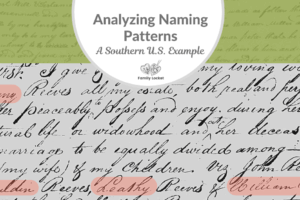Censuses and vital records are the backbones of genealogical research. Finding ancestors on every census and discovering their vital records can help a researcher begin to identify an ancestor and the familial relationships for that ancestor. Land and probate records are also valuable sources. But what happens when a search of these records doesn’t yield many results? Additional (and often less-used) records can then be examined with the goal of finding clues that will lead to more information about the ancestor. I recently finished a project where I relied heavily on city directories to help find new avenues of research. I will first describe city directories and how to use them, then use my research as an illustration.
What are city directories?

City directories were created for salesmen, merchants, and others interested in contacting residents of an area. They are arranged alphabetically into lists of names and addresses. They were typically published annually, and can include the following information:
– Name and occupation of head of household, usually men and female widows, although single employed females were later included
– Sometimes the name of spouse, often in parentheses following name of husband
– Names of children once they become employed outside the home
– Street name and house number of residence
– Occupation
– Work address, if employed outside the home
In addition, many directories provide a street index, which lists every house on the street in numerical order with the head of each household. This can be helpful in building a FAN club for your ancestor. Neighbors are often relatives or witnesses to life events. Non-related neighbors often married each other.
The Value of City Directories
City directories can be especially helpful when researching ancestors that resided in large cities where many people rented, rather than owned, their homes. Large cities were often homes to new arrivals or temporary residents that may have moved in and out of the area between censuses. City directories can also be used as an aid in finding elusive ancestors on censuses. Perhaps an ancestor’s name was indexed wrong so they don’t come up in searches of the indexed census. A city directory can provide an address which, when paired with a map of the city, can help you determine which portion of the census to manually search in order to discover your ancestor. When trying to match with a census year, look in the city directory for the year following the census, as directories were generally published one year after the city was canvassed.
Searching City Directories
Where can you find city directories? Many libraries and historical societies have city directories in their collections. Many have been microfilmed. The ancestors I was researching lived in Brooklyn, and I discovered that the Family History Library has Brooklyn City Directories for every year from 1822-1913 on microfiche. I found this record set by performing a keyword search for “Brooklyn City Directories” in the FamilySearch Catalog.
If you are unable to travel to the repository where city directories for your locality are held, there are a number of directories that have been digitized and are available online. Here are a few online resources to help you get started:
– Ancestry has a collection of city directories called U.S. City Directories, 1822-1995. The database is searchable, but you can also browse by location and year.
– Fold3 also has a collection of digitized City Directories for thirty large metropolitan areas in twenty U.S. states.
– Check university and local libraries in the area you are researching. Many have digitized collections of city directories.
– Google Books, HathiTrust Digital Library, and Internet Archive are other great places to look for digitized city directories.
Searching indexed databases may not be your best bet when trying to find ancestors in city directories. Names were often misspelled and the spelling can vary from year to year. Because the directories are arranged in alphabetical order, it is easy to browse through them and find your ancestor. Once you find the ancestor in the alphabetical list, don’t forget to go to the street index to see who their neighbors were. Another helpful thing to remember is that abbreviations may vary from directory to directory. For example, “r” could mean “renter” or “rear.” Look for an abbreviation guide somewhere in the directory so that you don’t misinterpret the abbreviations.

How have city directories helped in your research?
____________
Resources:
Kimberly Powell, “Using City Directories for Genealogy Research,” ThoughtCo. (https://www.thoughtco.com/city-directories-for-genealogy-1422322 : accessed 7 August 2019).
Lisa Lisson, “How to Use City Directories in Your Genealogy Research,” Are You My Cousin (https://lisalisson.com/how-to-use-city-directories-in-your-genealogy-research/ : accessed 7 August 2019).
Juliana Szucs, “Tips for Researching in City Directories,” Ancestry (https://blogs.ancestry.com/ancestry/2009/08/31/tips-for-researching-in-city-directories/ : accessed 7 August 2019).
FamilySearch Wiki, “City Directories,” FamilySearch (https://www.familysearch.org/wiki/en/City_Directories : accessed 7 August 2019).
















Leave a Reply
Thanks for the note!